|
FAQs about Whelks, Family
Buccinidae
Related Articles: Gastropods, Sea Slugs, Mollusks, Abalone,
Related FAQs: Marine Snails 1, Marine Snails 2, Marine Snails 3, Marine Snails 4, Snail ID 1, Snail
ID 2, Snail Behavior, Snail Selection, Snail Compatibility, Snail Systems, Snail Feeding, Snail Disease, Snail Reproduction, Mollusks, Sea
Slugs, Abalone,
|
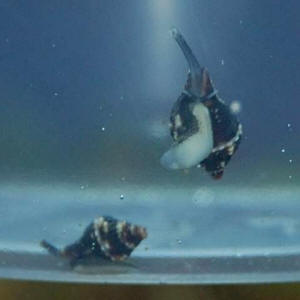 |
|
Pink snail
12/5/12
<What are you doing mate? We require that image files be at most a few
hundred Kbytes... yours are more than 10 Megs... have been deleted. Re-size
and re-send>
Hiya guys got this little snail/conch in a clean up crew purchase. He is a
nice pink and with shell about two inches long. It looks like he has a bit
of armour or something on his tail.
Re: Pink snail (re-sized)
12/5/12
<Thanks!>
Re: Pink snail
12/5/12
And the underside...>
Hiya guys got this little snail/conch in a clean up crew purchase. He is a
nice pink and with shell about two inches long. It looks like he has a bit
of armour or something on his tail.
<A Buccinoid; thought at first a true whelk; likely Fasciolaria tulipa,
carnivorous... Read here:
http://www.wetwebmedia.com/WhelkF.htm
and the linked files above. Bob Fenner>
|

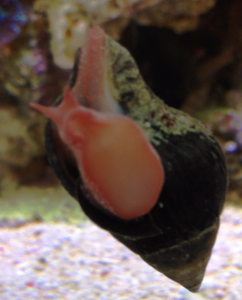 |
Re: Pink snail
12/5/12
Lynn, is this a juv. Fasciolaria tulipa?
<Well, the foot's the right color, but the anterior end of the shell doesn't
look quite right (not as slender/tapered as F. tulipa). I've been
looking around all morning for this snail but what I can see of it is so
"generic" that, combined with the fact that I don't know where it came from,
and the potential variance within a given species, I just can't pin it down
- Arghh! I'll get the reply wrapped up and sent along asap.
Thanks and take care, Lynn>
<<Thanks Lynn, B>>
A pleasure as always, Bob -Lynn
Re Pink snail: 12/5/12
Hiya guys
<Hi there, Lynn here today.>
…got this little snail/conch in a clean-up crew purchase. He is a nice
pink and with shell about two inches long.
<Hmmm, by any chance do you know what part of the world this snail
originated? How is it behaving? Have you seen it feeding, and if
so, what was it eating? The reason I ask is that it has some of the
same features as predatory/scavenger snails I’ve seen. It looks a bit
like the Tulip snail Fasciolaria tulipa (family Fasciolariidae) from the
Western Atlantic. The color of the foot/soft tissue certainly fits and
the general shape of the shell is similar, but not quite right.
Unfortunately, I’m not sure what species this is. In order to pursue
an ID, I’d really need to know where the snail came from, along with several
close-up, detailed photos of the shell – one taken from directly above
(showing the entire length), and one from below (showing the entire opening
of the shell). In lieu of an ID, I would simply recommend keeping an
eye on the snail along with your other livestock. I would also
recommend testing the snail by way of placing a bit of meat (shrimp, clam,
squid, or fish) nearby and seeing how it reacts. You might need to do
this after the lights are out if your resident fishes grab the food before
the snail can react! Just get out your handy flashlight/torch and spy
on the little fellow. If it makes a beeline for the scraps, you’ll
know the snail isn’t a harmless herbivore! If it does take the bait,
either find it another home, or keep it very well-fed. At two inches,
this snail is already going to have quite an appetite so you’ll want to
discourage it from preying on your other snails, bivalves, etc. If the
snail ignores the meat, do still keep an eye on it. It's possible that
it prefers live food over dead. If (after all this!) you’re able to
confirm that what you have is indeed an herbivore, do keep an eye on the
food supply. If it runs low, you might try offering some Nori (dried
seaweed sheets available at most grocery stores). Just attach some to
a small rock with a clean rubber-band. Please see the following link
for an example of F. tulipa:
http://www.jaxshells.org/ttulip.htm >
It looks like he has a bit of armour or something on his tail.
<What you’re seeing is the snail’s operculum which is a sort of trap door
attached to the foot. This allows the snail to seal itself inside its
shell and protect the soft tissue from predation and desiccation.
In this snail’s case, it’s more than likely oval or “comma” shaped, and made
of a thin, horny substance that appears fingernail-like in its thickness and
flexibility. Please let me/us know if there’s anything else I/we can do to
help. Take care, Lynn Z>
Re: Pink Snail – 12/6/12
No idea where he came from offered him some shrimp and got no response he
was in quite a small container with 7 snails and hasn't touched one. He
climbed all over my Zoa that's about it.
<Gotcha, just keep an eye on things and remove if/when necessary. Take
care, Lynn Z>
|
.jpg)
.jpg) |
|
Help in Invert ID
– 11/20/12
Hello Awesome WWM Crew!
Can you please help me identify this hitchhiker in my tank, and is it safe
to keep in a reef tank? Kinda like its appearance and I'm thinking of
keeping it :)
Thanks!
Gabe M
Can't make out what this is from your blurry pix Gabe. Can you provide some
that are better resolved? Have sent along to LynnZ for her go. Bob Fenner
|
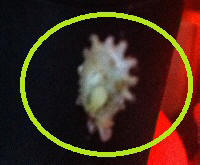
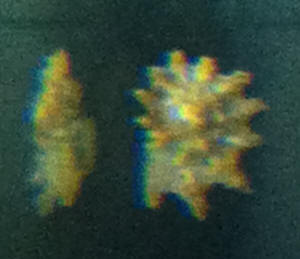 |
|
Re: Help in Invert ID
– 11/20/12
I'll try, the little bugger is a bit hard to find,
<Do send along a physical and behavioral description as well please>
just managed to snap this shot with my phone last night when it was in
broad *cough* daylight.
<A small digital camera is much better>
Will send a better one when I see it again.
Thanks, Bob.
<Welcome Gabe. B>
Re: Help in Invert ID
11/20/12
Thanks Bob, it looks like a Lithopoma/Astraea species of some sort.
I'll send Gabriel a reply (through WWM) ASAP!
Take care,
-Lynn
<Ahh, thank you Lynn. B>
Help in Invert ID – Turbinid and Possible Whelk – 11/20/12
Hello Awesome WWM Crew!
<Woohoo! Thanks, and hello to you too!>
Can you please help me identify this hitchhiker in my tank,
<It appears to be a harmless Turbinid (family Turbinidae) snail of some
sort. Could you tell me where it came from originally? Also, if you
could send along a more detailed photo (or two) and tell me the approximate
size that would be most helpful. Please see the following link for
examples of Turbinids (each photo is a link to more information and photos):
http://www.gastropods.com/Taxon_pages/TN_Family_TURBINIDAE.shtml#TURBINIDAEASTRAEINAE
>
…and is it safe to keep in a reef tank?
<If it is indeed a Turbinid, then yes, it’ll be fine. That is, it will
consume film algae, diatoms and the like, and will not pose a threat to any
corals or other livestock. All in all, it’ll be a terrific addition to
your clean-up crew. I’m actually more concerned about the snail seen
at the bottom of image 4111. It looks a lot like a whelk, a common
hitchhiker on live rock from Florida that preys on other snails and small
invert’s. Do send along a detailed photo or two and I’ll do my best to
confirm whether it could be a problem.>
Kinda like its appearance and I'm thinking of keeping it :)
<Yep, it’s a beauty alright!>
Thanks!
<You’re most welcome! Take care, Lynn Z>
Re: Help in Invert ID
11/21/12
Hey Bob,
<Big G!>
I think I know what snail it is, Lynn gave me an awesome link to help me ID
it.. from the looks of it, it's Bellastraea squamifera. Definitely a keeper
:D
Thanks, Bob
Gabe
<Cheers, BobF>
Re: Help in Invert ID – Turbinid and Possible Whelk – 11/21/12
Hello Lynn,
<Hello Gabe!>
Thank you for your reply and that really useful link.. definitely going to
my bookmarks :D
<You’re very welcome; I’m glad I was able to help.>
From there, I think it's Bellastraea squamifera, looks exactly like it, a
bit different on its shade but the resemblance is uncanny. It's about
a quarter of an inch across & flat when viewed on the sides. Awesome if it
is! :D
<Yes indeed! It’s definitely a pretty little snail, but time (and maybe a
bit more info) will tell regarding the ID. Complicating the issue is
the fact that your individual is most likely a juvenile and its shell may
significantly differ from than of an adult. We really need to find out
where the snail originated in order to have the best chance at a solid ID.
If it arrived on live rock, where was it from? At any rate, even
without that knowledge, I can tell you that your snail does not pose a
threat to other livestock so I say enjoy! For what it’s worth, here’s
another potential candidate (Astralium phoebium, aka the Long-spined Star
Snail):
http://www.gastropods.com/3/Shell_323.shtml >
I actually bought the snail at the bottom of the picture - four of them, LFS
said they're Nassarius. So far, they've been doing a good job at
eating detritus and left over food. Should I be concerned?
<Well, if it’s a true Nassarius, no. Just keep the snails well-fed,
since they’re mostly scavengers, and they should do just fine. The
trick is to find out whether they’re really Nassarius spp. snails or
something else entirely. Just out of curiosity, do your snails
look like the ones (Ilyanassa obsoleta, aka the Eastern Mud Snail) at the
following site?
http://z14.invisionfree.com/Conchologist_Forum/ar/t2240.htm?
If so, do use our Google search engine for more information and/or contact
me. Last but not least, please see the following link for more
information regarding Nassarius spp. snails, including how to recognize them
by a characteristic groove in their shell (start about half-way down the
page): http://web.archive.org/web/20010410073108/http://www.animalnetwork.com/fish/library/articleview2.asp?Section=&RecordNo=166
>
I'm planning to buy some more CUC inverts and I definitely don't want them
eating those O.O
<No, indeed!>
Thanks!
<You’re most welcome!>
Gabe M
<Take care, Lynn Z>
Re: Help in Invert ID – Turbinid and Possible Whelk – 11/22/12
Howdy Lynn,
<Howdy Gabe>
I'm afraid there's no way to really know where the rock came from.. But I'm
in the tropics so the Liverock would also be from the surrounding regions,
if that's any help at all.
<No worries, suffice it to say that it’s a beautiful little snail and
harmless to boot!>
For the other snail, it doesn't look like any of those Ilyanassa obsoleta
ones.
<Good, those are a cooler-water species that have been sold online and in
some of the LFS in the US as a Nassarius spp. (but they're not!), so I
thought I’d cover that base just to be sure. If you’re outside of the
US in the tropics, then chances are good that your LFS won’t be offering
those snails.>
Although, it doesn't look quite exactly like the Nassarius spp snail either.
I'll check later if they have that groove in their shells.
<Sounds good. Do let me/us know if you need any more assistance with
the ID.>
So far they have been laying eggs like crazy in the tank (same in appearance
with the Nassarius eggs when I searched).
<Gotcha>
And I read somewhere, and I don't know how true, that snails laying eggs are
indications that they are eating well?
<That’s what I’ve heard/read as well.>
I did notice a hitchhiking brittle star with missing legs though, and
another hitchhiking clam that mysteriously got emptied out.
<It happens. Hitchhikers can really get banged up and exposed to all
sorts of stresses during collection, transit, and curing. Regarding
the clam, sometimes they just don’t have enough food, especially in a new
tank, to sustain them so they die and the scavengers feast. >
They should not suppose to eat anything still alive right?
<Well, Nassarius spp., snails are scavengers that are attracted to dead
and/or damaged/dying tissue so healthy animals are safe while wounded
individuals may well be targeted (especially if there’s not enough available
food otherwise).>
I mean, I've seen them "walking" over the YW goby
<Do I ever love those comical little fishes!>
..and they literally smother him all over, tumbling the goby sideways,
turning him upside down.. in other words, really inappropriate ways :D .
The goby doesn't mind them at all, just lets them do as they please with
him.
<Heheeee! That is one tolerant little goby!>
If they ate the clam/star, I would think they would do the same with the
goby seeing that the fish isn't making any effort to escape their slimy
molestations :D
<Heeee, yes indeed! Any opportunistic predator worth its salt would
never turn down a meal that just sits there and allows itself to be mobbed!
Obviously the goby doesn’t perceive the snails as any sort of threat.
I would just keep an eye on the situation, keep the snails well-fed, and
only remove if/when necessary.>
Thanks,
<It was my pleasure, Gabe. Again, if there’s anything else we can do
for you, just let us know.>
Gabe M
<Take care, Lynn Z>
|
|
What is this growing in my tank???? Snail Egg Capsules
– 3/7/12
<Hello there, Lynn here today.>
I found this growing at the base of my finger
leather. Over the next two days it began growing all
over and onto the base of it. I just removed it, hopefully.
It is firm but yet flexible. It feels like bristles. Any
ideas?
<Yep, you have what appears to be a grouping of snail egg
capsules. I’ve seen similar clusters from snails in the
family Muricidae (a large group of predators commonly referred to
as Murex, Drills, Rock snails, etc.). It could also be from
something else like a Whelk of some sort. By any chance do
you have any snails in your system, and if so, what species are
they? Please see the following links for examples of Murex
capsules:
http://www.jaxshells.org/0318aa.htm
http://www.jaxshells.org/20029.htm
http://www.wildsingapore.com/wildfacts/mollusca/gastropoda/muricidae/bumpy.htm
>
How did it get in my tank?
<One snail (or several) deposited them.>
Me pulling it out, could I have spread it and made the problem
worse?
<Nope, once removed, the snails won’t have the opportunity
to hatch.>
Please let me know as soon as you can!
<Hope this helps! Take care, Lynn Z>
|
|
[1].JPG)
|
Re: What is this growing in my tank???? Snail Egg
Capsules – 3/7/12
Thank you.
<You’re very welcome.>
If some indeed do hatch, is this bad?
<It all depends on the species and its diet.>
Is this a bad kind of snail species to have?
<Unfortunately, I don’t know what species it is, so I’m not
sure. >
I have quite a few kind of snails in my tank...not sure what
all they are.
<If you could send some photos, I could take a look and try to
narrow things down a bit.>
Should I be concerned?
<Well, if these capsules are from a snail (or snails) that
you’ve had for quite awhile and you haven’t had any problems,
then you may be okay. Just keep an eye out for trouble and
remove if/when necessary. If however, the capsules are from
an as yet unseen snail (or snails) that hitchhiked in on a recent
purchase, then it could go either way. If it were me, I’d
remove them. I think the chances are better than 50-50 that
they’re from some sort of predatory snail and it’s just not
worth taking the risk. Take care, Lynn Z> |
|
ID Please. Think I know what it is – Cone
Snail. Possible Whelk – 2/28/12
Hello Bob and Crew!
<Hello Mike, Lynn here today. What’s up?>
Was looking at new corals just in from Australia yesterday
<Beautiful!>
…and noticed his feeler out. He came from under a
chalice!!!!
<Sneaky snail!>
Only his shell is a little more on the black side from photos
I
<Is there some text missing here? No worries, the snail
does not appear to be a cone snail, but instead possibly a Whelk
(Superfamily: Buccinoidea), Strombus (Superfamily: Stromboidea,
Family Strombidae), or Murex (Superfamily Muricoidea) of some
sort. That covers an awful lot of ground!
Unfortunately, I can’t see enough detail to narrow the ID
further or tell you with any certainty whether the snail poses a
threat to your livestock. It could be a carnivorous
predator and/or scavenger, or something similar to a Columbellid
(Superfamily Buccinoidea, Family Columbellidae) that grazes on
micro-algae. I would test this snail by offering a meaty bit
(shrimp/fish/clam, etc.) and see how it reacts. If it takes
the bait, and you choose to keep it as a scavenger, do keep it
well-fed, watch for damage to livestock, and remove if/when
necessary. Please see the following links for examples of
the above-mentioned groups:
Superfamily Buccinoidea:
http://www.gastropods.com/Taxon_pages/SuperFamily_BUCCINOIDEA.shtml
Family Strombidae:
http://www.gastropods.com/Taxon_pages/TN_Family_STROMBIDAE.shtml
Superfamily Muricoidea:
http://www.gastropods.com/Taxon_pages/SuperFamily_MURICOIDEA.shtml
Also, do please check Bob’s article/photos at the following
link, as well as the related links/FAQ’s at the top of the
page: http://www.wetwebmedia.com/gastroart2.htm >
Thanks!
<You’re very welcome!>
Mike Snyder
<Take care, Lynn Z>
www.thecoralshop.com
|
|
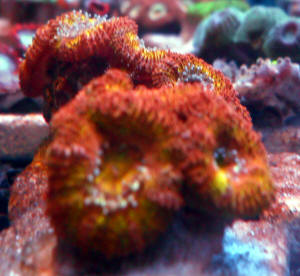 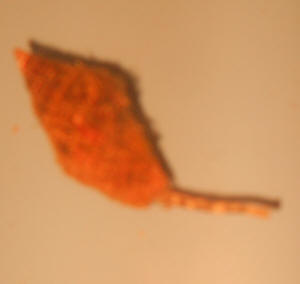
|
|
Good or bad guy? Whelk ID,
rdg. 1/11/12
Hi,
<Hello>
I spotted this snail wandering around my reef tank and did a bit
of research to try and find out if it's a good guy or not. I
came across two possible options: that it's a type of whelk
called Engina Zonalis (apparently a bad guy in a reef tank) or a
Bumblebee Snail (a good guy in a reef tank). To make things even
more confusing I found quite a few people stating that a
Bumblebee Snail IS an Englina Zonalis.
<Mmm, beware of common names, even some scientific... there
are quite a few "bumblebee snails"... One Buccinid is
Pusiostoma zonalis... and you may well find its name as
Pusiostoma (Engina) mendicaria; designating that it was formerly
placed in the genus Engina (but now resides in the genus
Pusiostoma... What you appear to have may be Engina zonalis;
closely related>
From a post on your site it looks like it's the former which
is bad news as it's a very pretty snail and I would be sad to
get rid of it. I was satisfied with this conclusion until I came
across all the conflicting information on the internet and became
unsure.
Before I try and give him to my LFS (unlikely they will accept)
or worse, could you please clear up the mystery?
<Ahh, either put the genus name in the WWM search tool (on
every page), or look up (the indices) re Whelks... and
read>
Kind regards and many thanks for the wonderful site,
<Please use it. Bob Fenner>
Ian Pugh
|
|
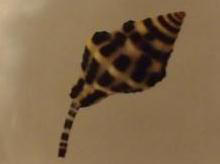
|
Whelks: Cold Water spp. Needing an Appropriate System
-- 12/5/11
Hello!
<Hello there! Lynn here today, how may I help you?>
After the mysterious disappearance of my wrasse (eaten by the remora,
presumably),
<Remoras are certainly voracious eaters. They'll eat
pretty much anything, anytime.>
I am once again open to the world of inverts. I've been
wanting some huge snails, and went down to the local Asian market, and
picked up a few large Kellet's Whelks, and a few even larger
Channeled Whelks.
<Hmmm, you don't mention whether your tank is a cool/cold water
or reef system, but since Remoras are supposedly all tropical to
sub-tropical, I'm guessing it's the latter. The problem
with that is the issue of both snails more than likely originating from
the cooler waters off the coast of California. Exposure to warmer
water speeds up the snails' metabolism and results in premature
death. Have you ever heard the expression 'The candle that
burns twice as bright burns half as long'? That applies
here.>
So far, they are mostly sitting in one place, moving small amounts
every night. The larger of the Kellet's have finally gotten around
to eating. (Squid, and live periwinkles).
<In the wild, Kellet's Whelks (Kelletia kelletii) are
carnivorous predators and scavengers that consume all sorts of
invertebrates including sessile, tube-dwelling worms, solitary
Ascidians/tunicates, other snails, and dead and dying fishes,
etc. Channeled Whelks (Busycotypus canaliculatus), on the other
hand, mainly prey on bivalves -- clams, mussels and oysters. I
would try offering any meaty food of marine origin but be sure to
observe the Channeled Whelks to ensure that they're eating/getting
enough. If not, offer one/some of the bivalves mentioned above.
Please see the following links for more information:
Kellet's Whelk:
http://www.sanctuarysimon.org/species/species_info.php?speciesID=136&search=genus
Channeled Whelk: http://www.exoticsguide.org/species_pages/busycotypus.html
>
My question is about husbandry of these guys. I can't really find
much of anything on them aside from a bit on diet. I'm especially
interested in temperature requirements.
<Judging from the likely origin of the California coast, I'd say
somewhere in the fifties or sixties (degrees F). In order to
achieve this, you'll need to set up a cold water system (if you
don't have one already). Please see the following links for
more information:
http://www.wetwebmedia.com/cold.htm
http://www.wetwebmedia.com/ColdH20PacSysArt.htm
You'll also need a sizeable system as well, since these snails can
get pretty large (up to ~6.9 inches/17.5 cm for the Kellet's Whelk
and ~7.3 inches/18.5 cm for the Channeled.)>
In the past week or two they have gone from barely alive, to moving
around and eating, so I'm assuming they don't need insanely
cold water at least.
<Nope, but they do need water much cooler than typical reef
tanks. Put in "people" terms, I might be able to get
used to being trapped in a house that's a consistent 120 degrees,
and I would eat when I finally got hungry enough, but I'd have the
temperament of a wounded wolverine. I definitely wouldn't be
thriving and neither will those snails if they're kept in higher
than optimal temperatures!>
Will I have problems with them trying to eat each other?
<It's entirely possible, especially if they get hungry
enough. These are large snails with matching appetites.>
Also, due to them eating periwinkles, would it hurt anything to add a
few generic small hermits in the tank, just to see what they do with
the shell piles?
<I wouldn't do anything at this point beyond getting the snails
into an appropriate system or finding them a new home. Do read
through Bob's articles linked above so you'll know what
you're getting into with regards to cold water systems. Given
the right livestock and set up, you could end up with a beautiful
tank!>
Thanks for the help.
<You're very welcome and good luck! Take care, Lynn Z>
|
Snail -- Gemophos spp. Whelk: 9/20/11
Hello WWM Saviors!
<Hello Jeremiah, how may I help you today?>
I have been having some mysterious disappearances overnight in my
new office 2.5G Reef tank (button polyp and a lot of macro
algae). I've noticed this hitchhiker snail hiding during the
day, but he came out this afternoon so I could snap a picture. Is
it a Nassarius?
<It's a cousin of sorts -- a Whelk in the genus Gemophos
with what appears to be a harmless Collonista snail along for the
ride. Please see related FAQ's at the following link for more
information/photos: http://www.wetwebmedia.com/WhelkF.htm
Enter 'Gemophos' in our Google search engine at the
bottom of this link for more references:
http://www.wetwebmedia.com/Googlesearch.htm
>
Predatory?
<Most definitely, these snails prey on sessile invertebrates
and other Gastropods.>
Should I remove?
<Definitely>
It is Florida LR (in case it helps ID).
<Thanks -- yep, this particular snail is a common stowaway on
live rock from Florida. I typically get one or several with every
shipment, so keep an eye out for others. It's a shame because
they're actually very pretty, but unfortunately, they can do
some damage to your snail population. By the way, these snails
would not be the culprits consuming/doing damage to your button
polyps or algae. Check your water parameters and keep an eye out,
especially at night, for any other possible culprits.>
Thanks, you guys/gals are awesome!
<Why thank you!>
Jeremiah
<Take care, Lynn Z>
|
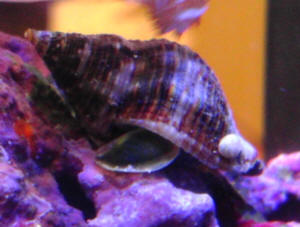 |
|
Please help... Nassarius or Whelks
7/3/2011
I have a 110 gallon tank with a 55 gallon tank as a sump. It is a
recent upgrade from a 75 gallon non drilled tank. but the system
has been running for about 8 years. The system seems to be
healthy, all water parameters are in check, tons of copepods
& amphipods are thriving. All corals have great polyp
extension and showing signs of growth. Other than finding a
couple dead hermits, everything else seems to be running
great.
<Ah, good>
I have recently purchased Nassarius snails for the tank about a
month - month and a half ago. I have included pictures of both
the larger snails that I purchased and a baby that I have seen 4
or 5 of in the last 2 days.
<... the larger snails are Nassarius obsoleta.( ILynassarius
obsoleta)>
The babies appear to have the same coloration and similar shape
as the grey and white striped one in the pictures. Their snout is
white in color but hard to see in the photos because they are so
small. Any help is appreciated. Thanks for taking the time to ID
these little guys.
I am hoping that you can tell me that my larger snails are in
fact Nassarius Snails, and if possible an ID on the babies would
be much appreciated.
<The smaller animals look like some sort of Whelk to me; and
too likely predaceous. I would remove them>
Thanks for your time and help.
Kimber
<Bob Fenner>
|
|
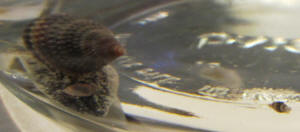 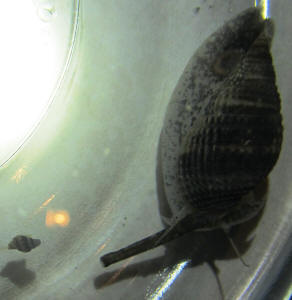
|
|
Snail ID Request -- Whelklets in My Nano? Yes!
3/30/11
Hello,
<Hello Ken, Lynn here today.>
I've recently discovered two small snails in my 14 gal. Nano
reef tank that look like they might be bad guys.
<You'd be right!>
After searching a variety of Web sites, including the generous
amount of wonderful info on WWM, my eyes have crossed and
I've decided to appeal to the experts. What might they
be?
<They're whelks of some sort (family Buccinidae, subfamily
Pisaniinae). Do you know where they originated? If it was from
around Florida, they're most likely one of the following
species: Gemophos tinctus (the Tinted or Painted Cantharus),
Gemophos auritulus (the Gaudy Cantharus), or something like
Engina turbinella (the White-spotted Engina/Spotted Lesser
Whelk). The Gemophos species both have mottled shells of varying
color and the same spotted/mottled soft tissue I see in one of
your individuals. Unfortunately, I can't find a good photo of
the soft tissue of E. turbinella for comparison. Beyond that, the
ID is complicated by the degree to which each species can vary in
color, pattern, and shell structure. For example, Engina
turbinella can appear heavily spotted or thinly banded. I'd
need detailed, close-up photos (especially of the lip
area/aperture), and the location of origin, in order to proceed
further.>
Will they get huge, or stay small
<If they're one of the Gemophos species, they can reach a
maximum shell length of ~1.25'/32mm (G. tinctus) to
~1.4'/35mm (G. auritulus). Engina turbinella, on the other
hand, tops out at a diminutive .6'/16mm.>
..and cute?
<Definitely! I think they're neat-looking little snails.
It's just a shame they're not good candidates for a mixed
reef system.>
Are they killers, or star Hoovers for the clean-up crew?
<Heeeee! These snails have the potential to be star Hoovers
*of* the clean-up crew! They're opportunistic, carnivorous
predators and scavengers. Unfortunately, I don't have any
details regarding the specific diet of Gemophos auritulus or
Engina turbinella, but I can tell you that although Gemophos
tinctus has a preference for sessile invertebrates, it will also
prey on other snails and bivalves. Trust me, I've seen it
first-hand! The bottom line is that I wouldn't trust any of
these species around other snails. For more information/photos on
these species, please see the following links:
Gemophos tinctus: FAQ titled 'Snail ID: Predatory/Scavenging
Whelk -- 2/12/10' (refer to links within as well):
http://www.wetwebmedia.com/WhelkF.htm?h=
http://z14.invisionfree.com/Conchologist_Forum/index.php?showtopic=1710
Gemophos auritulus: In situ: http://www.jaxshells.org/2295anne.htm
http://z14.invisionfree.com/Conchologist_Forum/index.php?showtopic=1711
http://www.gastropods.com/7/Shell_1927.shtml
>
Engina turbinella: http://www.gastropods.com/4/Shell_1924.shtml
http://z14.invisionfree.com/Conchologist_Forum/index.php?showtopic=1908
>
I've attached two pictures showing tops and bottoms.
<Thank you! Good photos make all the difference when it comes
to ID work.>
The shell of the larger snail is about 1/4 inch long. I currently
have them quarantined until I can figure out if they are safe to
keep. Please advise: should they stay, or should they go?
<They should go 'or as Arnold would say 'Hasta la
vista, baby'. You could always set them up in a separate Nano
system if desired. Just offer meaty bits of marine origin (fish,
clam, squid, etc.) or possibly sinking pellets designed for
shrimps, crabs, and the like.>
Thanks for your help, and for all the great work you do to
maintain this amazing Web site!
<You're very welcome and thank you!>
Ken
<Take care, Lynn Z>
|
|
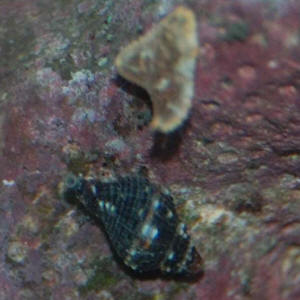 
|
What To Feed Newly Hatched Whelk? 12/2/10
Hi there - thanks for this outstanding portal of information!
<Hi Sue, and you're welcome.>
While walking the beach a few months ago I found something
"strange" and being obsessed with finding out what it was, I
brought it home and started Googling. It wasn't easy to do (since I
had no idea what words to enter in the search engine) but finally
discovered that what I had found was a string of whelk egg casings. Not
knowing if there was anything viable left in it (some of the capsules
seemed to still have some fluid in them)
<A tell tale sign is small holes in the casings indicating the newly
hatched whelk has ate its way through.>
I quickly threw together an empty 14 gallon Biocube with some live sand
and water from my reef tanks and put the casing in there. I had also
picked up some rocks and "clustered" snails on the shore so I
added them to the tank, too.
<Will soon become meals for the whelks.>
Low and behold, I have noticed several baby whelk on the glass over the
past few days! I have no idea what I'm going to do with them when
(if) they get bigger but for now I am fascinated that they hatched and
would love to keep them alive. Any idea what I should feed them?
<Most are active predators and will bore their way through snail and
clam shells to dine on the inside.>
I've learned from reading that the hatched whelks eat the
unhatched/unfertilized whelk eggs but that won't hold them for
long. I know the adult whelks dine on clams
<And snails.>
so should I start putting raw clam meat in the tank?
<You can try this, may or may not be acceptable.>
Any suggestions or advice on rearing these fosters would be
appreciated.
<May want to read through our FAQs here.
http://www.wetwebmedia.com/WhelkF.htm>
I am heavily into animal rescue and rehab but I can honestly say this
is my first attempt at orphaned
whelks!
<Mmm, any further advice Bob?><<Mmm, nope>>
Thanks in advance.
<You're welcome. James (Salty Dog)>
Sue Alexandre
|
Snail ID: Predatory/Scavenging Whelk --
2/12/10
Hello,
<Hello Mike, Lynn here this evening.>
I searched through all the snail ID posts but couldn't find
anything that I thought to be an exact match. I would like an ID
of this hitchhiker snail I acquired yesterday.
<It's a Whelk, family: Buccinidae Pisaniinae.>
I'm going to assume it's not a welcomed snail as I came
home to find it attached to one of my Astraea snails. I quickly
separated them and quarantined the hitchhiker.
<Good>
Here is a picture.
<From what I can see, your little snail looks very much like a
predatory Whelk known as Gemophos tinctus, aka the Tinted or
Painted Cantharus. Information can also be found on the
'net/elsewhere under several obsolete names, including Pollia
tincta and Cantharus tinctus. These snails prey mostly on fellow
Gastropods and Bivalves, but also scavenge and can get up to
about 1.25' in length. You did the right thing in getting
that little guy out of there! For more information/photos for
comparison, please see the following links:
http://www.jaxshells.org/gtinc.htm
http://www.gastropods.com/8/Shell_3228.shtml >
I would be glad to send more photos if needed for proper ID.
<Thanks. If what you have doesn't seem to be Gemophos
tinctus, and you'd like to pursue an ID, please send along a
photo (or several) showing the other side of the snail, as well
as location of origin (if known). If the snail hitchhiked on
rock, etc., from around Florida or the Gulf of Mexico, chances
are good that it's G. tinctus. It's a very common
species. I've gotten at least several with every live rock
order I've placed from Florida. Here's a photo of the
last one I received:
http://bb.wetwebmedia.com/gallery/viewpic.php?pic_id=391 .
All in all, they're beautiful little snails, but
unfortunately not so great in a mixed reef system.>
Thank you!
<You're very welcome!>
--Mike
<Take care, LynnZ>
|
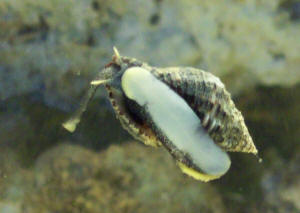 |
|
Re: Snail ID: Predatory/Scavenging
Whelk -- 2/13/10
<Hello Mike!>
Thank you very much!
<It was a pleasure.>
That's about what I figured. I looked at one of the pictures
in the first link you provided and it looks exactly like what I
have.
<Yay! By the way, I was able to find a bit more information
specifically related to the diet of G. tinctus (as opposed to
Whelks in general). Apparently, their prey of choice includes
mostly sessile invertebrates such as barnacles, tube-dwelling
Polychaetes, Vermetid Gastropods, and the like. I can tell you
from experience however, that they will also prey on other
Gastropods. The bottom line is that these snails are carnivorous
predators and scavengers that when hungry enough will go after
whatever food they can find/eat.>
Thank you once again!
<You're very welcome!>
Cheers --Mike
<Take care, LynnZ>
PS: It did come attached to a live rock that I just
purchased.
<Yep, that's typical.>
|
|
|

